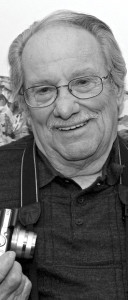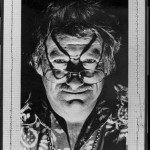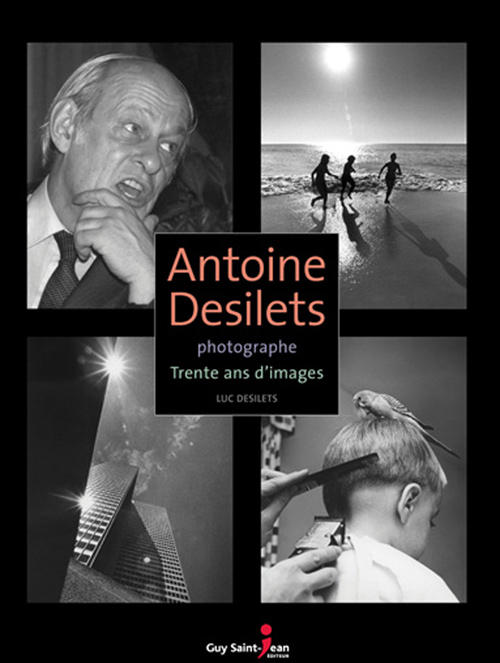 Our PhotoNews team had the pleasure of visiting Antoine Desilets, his lovely wife, Jeannine, and their son, Luc, who presided over the recent publication of Antoine Desilets, Photographe, Trente ans d’images (Thirty Years of Images) from Éditions Guy Saint-Jean, a tribute to the accomplishment of the man, now 84, but still sharp as a tack, with a wry sense of humour.
Our PhotoNews team had the pleasure of visiting Antoine Desilets, his lovely wife, Jeannine, and their son, Luc, who presided over the recent publication of Antoine Desilets, Photographe, Trente ans d’images (Thirty Years of Images) from Éditions Guy Saint-Jean, a tribute to the accomplishment of the man, now 84, but still sharp as a tack, with a wry sense of humour.
Back to health after an operation that has made him, by his own account, a “cyborg”, he seemed happy to see his old friends Jacques Dumont, former publisher of Photo Sélection (and later Photo Digest), a magazine to which he contributed right from the start, giving it much of its credibility, and André Dal Pont, director of photography for the magazines for more than 20 years. For my part, I felt privileged to meet a photographer of Antoine Desilet’s stature.


Desilets, a solitary man, kept to the shadows during his career, but he wanted to take pictures unlike anything that was seen in the press at that time, and, unbeknownst to him, his work was going to change the whole medium. He didn’t want his pictures to just fill in the blanks as many deskmen thought they were for. Pictures, to Antoine, had to speak or convey messages as much as text, and he wanted them to have depth, in all meanings of the word, while playing on all levels. Enthused and passionate, without any hesitation that he would bend or break the norm, giving form to his unique vision. Interested in everything, and excelling in everything he undertook, he extended his talents to portrait, sport, architecture, politics, social interests and even the “dead street dog” stories as they were called in the newsroom. All this was done with trademark humility, incarnating “the new photojournalist”, the new photographer.
 Pictures surround us in his apartment as he recounts his life story, all 84 years of it, and it is with delight and wonder that we discover some of these images, and look upon some with an older eye. All of the photographs touch us and many make us smile. Desilets has some 120,000 pictures behind him, the rights to most of which have been given to the National Archives of Québec.
Pictures surround us in his apartment as he recounts his life story, all 84 years of it, and it is with delight and wonder that we discover some of these images, and look upon some with an older eye. All of the photographs touch us and many make us smile. Desilets has some 120,000 pictures behind him, the rights to most of which have been given to the National Archives of Québec.
After a correspondence course and a solid training in photography with the Royal Canadian Air Force at Rockliffe, Antoine Desilets became a freelance photographer while selling cameras at L.L. Lozeau, and Henri Savard Photo. He also worked as an industrial photographer at Canadair. In 1959, he got his first crack at photojournalism at David Bier Studios, where he specialised in sport photography, and in 1961, the newspaper La Presse offered him a job. He started with the Magazine La Presse, a weekend supplement in colour, something other photographers were not interested in – and he built his own E3 darkroom in the newspaper building. Not fond of letting a deskman pick the pictures to “fill in” empty spaces, he made a habit of giving them his selection of the three best shots instead of the usual contact sheet, claiming that the others were unusable. In 1966, he became President of the Québec Press Photographers Association and started entering the National Press Photographers Association’s contests, winning numerous prizes. In 1974, he left his well-paid job for a start-up newspaper, Le Jour. “I’m a media guy” he reflects as he muses on the pleasure he felt knowing his pictures were finding their way into thousands of homes through newspapers and other publications.
 Be it humanistic, poetic, or comical, Desilets has no specified angle behind his works – or perhaps it is oddity, for originality prevails in his every shot. It is not enough for a photographer to have a good eye – pictures from masters such as Desilets have been thought out and conceptualized to convey a subtle message to their audience. All of his photographs are well worth their thousand words. Being different implies creativity and imagination, fairly difficult qualities to teach, but mastering the technical aspect is always helpful. He enumerates openly his many tricks: playing with the hyperfocal, favouring image depth, and opting for depth of field to name but a few. “I’m a car guy” he says, “I adjust the camera to the hyperfocal” as he tells us that many of his pictures were taken from his car. If contemporaries like Cartier-Bresson and Doisneau have inspired Desilets, none had as much influence as Andreas Feininger, the Time Life photographer. Antoine read and re-read all of Feininger’s books, especially The Creative Photographer.
Be it humanistic, poetic, or comical, Desilets has no specified angle behind his works – or perhaps it is oddity, for originality prevails in his every shot. It is not enough for a photographer to have a good eye – pictures from masters such as Desilets have been thought out and conceptualized to convey a subtle message to their audience. All of his photographs are well worth their thousand words. Being different implies creativity and imagination, fairly difficult qualities to teach, but mastering the technical aspect is always helpful. He enumerates openly his many tricks: playing with the hyperfocal, favouring image depth, and opting for depth of field to name but a few. “I’m a car guy” he says, “I adjust the camera to the hyperfocal” as he tells us that many of his pictures were taken from his car. If contemporaries like Cartier-Bresson and Doisneau have inspired Desilets, none had as much influence as Andreas Feininger, the Time Life photographer. Antoine read and re-read all of Feininger’s books, especially The Creative Photographer.
Desilets is not gear obsessed. Bigger isn’t better for him, as he prefers a discreet approach. The camera that served for most of his shots is a good old Nikon SP (with four lenses) bought in 1962-63, that camera is now displayed in the L.L. Lozeau store in Montreal as it was used to the point that it could not be repaired! During our visit, André Dal Pont had a 3D Fujifilm W3 compact camera with him, and the maestro got a real kick out of it and could not refrain from stating, “This is what I’ve always wanted to do, to give more depth to the image”. He was there, in front of us, as passionate as ever in his craft.
 If one were to retrace Canada’s Fathers of Photography, the eminent historian Michel Lessard would rightly point to Livernois and Notman as the first to introduce the art of photography in the province of Québec and possibly in the country. If Antoine Desilets cannot be recognized among these founding fathers of the craft, he will certainly have his name set in history as a Master of the Art of Photography for the quality of his work and the extent that he revolutionized photojournalism in the 60’s and 70’s. His award-winning pictures touched millions of people over the years and the few hundred images appearing in the book recently published give us a glimpse of the scope of his talent.
If one were to retrace Canada’s Fathers of Photography, the eminent historian Michel Lessard would rightly point to Livernois and Notman as the first to introduce the art of photography in the province of Québec and possibly in the country. If Antoine Desilets cannot be recognized among these founding fathers of the craft, he will certainly have his name set in history as a Master of the Art of Photography for the quality of his work and the extent that he revolutionized photojournalism in the 60’s and 70’s. His award-winning pictures touched millions of people over the years and the few hundred images appearing in the book recently published give us a glimpse of the scope of his talent.
Antoine Desilets is also a Master of Photography for having taught the art to generations with 11 books published (Learn photography, Darkroom…), in French and translated into English, Spanish and Portuguese with some 700,000 copies sold, making him our “George Eastman” for the popularisation of his art. He also penned many articles for magazines and newspapers, and taught in Senegal (he even declined an offer from Cornell University in New York). Even in this last book, celebrating his life and work, he felt the need to share a few tricks and ideas with the same generosity that has always been part of him. Thank you, Monsieur Desilets – you truly are a Grand Master of Photography!








